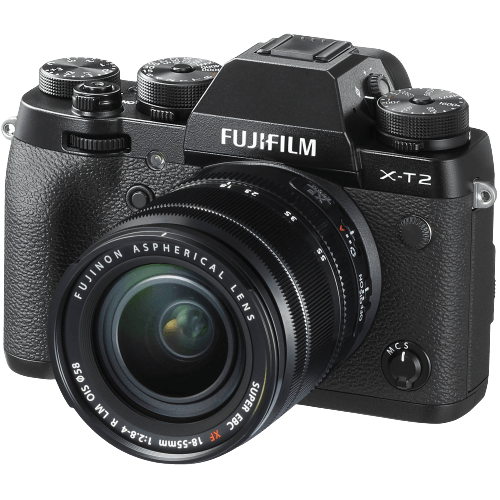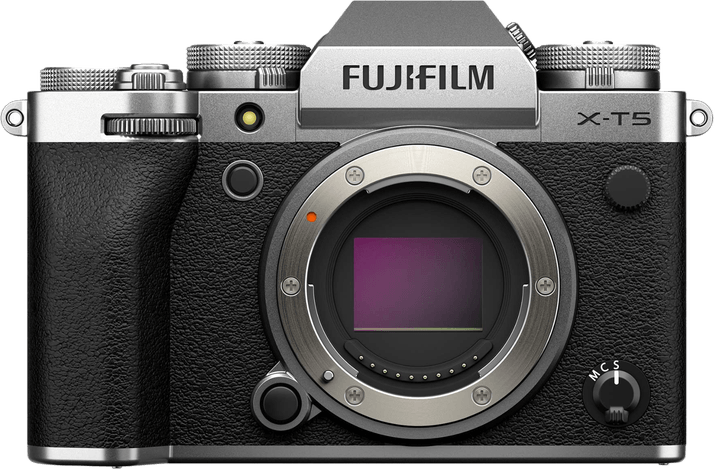Fujifilm X-T2 vs X-T5 Comparison
Fujifilm X-T2

Fujifilm X-T5

The Fujifilm X-T5 emerges as the winner with a score of 81/100, while the Fujifilm X-T2 scores 68/100. Both cameras are mirrorless and have similar sizes, with the X-T2 measuring 133 x 92 x 49mm and the X-T5 at 130 x 91 x 64mm. They also share close release dates, with the X-T2 from 2016 and the X-T5 from 2022.
The X-T5 has a higher score due to its better features. It comes with a $1699 launch price, just $100 more than the X-T2’s $1599. The extra cost is justified by the improvements in the camera’s performance and capabilities.
On the other hand, the X-T2 is lighter, weighing 507g compared to the X-T5’s 557g. This makes it easier to carry around during photography sessions. However, this advantage is not enough to outperform the X-T5’s superior features.
Ultimately, the Fujifilm X-T5 is the better camera, offering more advanced technology and improved performance for a slightly higher price. The Fujifilm X-T2, while lighter, falls short in terms of overall capabilities.
Fujifilm X-T2 vs X-T5 Overview and Optics
The Fujifilm X-T5 outperforms the Fujifilm X-T2 in optics, scoring 81/100 compared to the X-T2’s 66/100. Both cameras share several specifications, including a CMOS sensor type, Fujifilm X lens mount, and an APS-C sensor size. Neither camera has a DXOMARK score, as DXOMARK does not score Fujifilm cameras.
The X-T5 surpasses the X-T2 in several aspects, contributing to its higher score. First, the X-T5 boasts 40 megapixels, while the X-T2 has only 24 megapixels. This difference allows the X-T5 to capture higher resolution images with more detail. Additionally, the X-T5 has a faster shooting speed of 15, compared to the X-T2’s 14, enabling it to capture images more rapidly. The X-T5 also features a more advanced X-Processor 5, compared to the X-T2’s X-Processor Pro, which results in better image processing capabilities. Lastly, the X-T5 offers image stabilization, a feature absent in the X-T2, providing steadier shots and reducing the likelihood of blurry images.
The X-T2, despite its lower score, still has some advantages. It is a more affordable option for those who do not require the advanced features of the X-T5. Furthermore, the X-T2 maintains a loyal following among Fujifilm enthusiasts, thanks to its reliable performance and user-friendly design.
Taking these factors into account, the Fujifilm X-T5 is the superior choice for those seeking better optics, higher resolution images, faster shooting speeds, and image stabilization. However, the Fujifilm X-T2 remains a viable option for those on a budget or who prioritize simplicity and user-friendliness.
Fujifilm X-T2 vs X-T5 Video Performance
The Fujifilm X-T5 outperforms the Fujifilm X-T2 in video capabilities, boasting a video score of 87/100 compared to the X-T2’s score of 83/100. Both cameras share some common specifications, such as a maximum video frame rate of 60fps and built-in time-lapse functionality. However, the X-T5 surpasses the X-T2 in terms of video resolution and dimensions.
The X-T5’s maximum video resolution is 6K, while the X-T2’s is 4K. Additionally, the X-T5 has larger video dimensions of 6240×4160, compared to the X-T2’s dimensions of 3840×2160. These higher specifications make the X-T5 superior for capturing detailed, high-resolution video footage.
On the other hand, the X-T2 does not offer any significant advantages over the X-T5 in its video capabilities. The shared features, such as 60fps frame rate and time-lapse functionality, do not give the X-T2 an edge in this comparison. Therefore, the X-T5 remains the better choice for videographers seeking enhanced video performance.
Considering the differences in video performance, the Fujifilm X-T5 is the clear winner in this comparison. Its higher video score, 6K resolution, and larger video dimensions make it a more capable camera for capturing high-quality video. The X-T2, while still a strong contender, falls short in these critical areas. Videographers should opt for the X-T5 to ensure the best possible video quality and performance.
Fujifilm X-T2 vs X-T5 Features and Benefits
The Fujifilm X-T5 emerges as the winner in features, scoring 85/100, while the Fujifilm X-T2 lags behind with a score of 70/100. Both cameras share some common specifications, such as a 3-inch screen size, the absence of GPS, and the presence of WIFI and Bluetooth connectivity.
The X-T5 outperforms the X-T2 in several aspects, most notably in screen resolution and touchscreen functionality. The X-T5 boasts a higher screen resolution of 1,840,000 dots, providing users with a sharper and more detailed display. Additionally, the X-T5’s touchscreen capability allows for more intuitive control and ease of use, streamlining the overall user experience.
Though the X-T2 falls short in comparison, it still offers some noteworthy features. Both cameras have a flip screen, which is beneficial for capturing images from various angles and for vlogging purposes. However, the X-T2’s lower feature score indicates that, despite a few similarities, the X-T5 is the superior camera in terms of overall functionality.
When examining the features of these two cameras, it becomes evident that the Fujifilm X-T5 provides users with a more advanced and user-friendly experience, thanks to its higher screen resolution and touchscreen capabilities. While the Fujifilm X-T2 may still be a viable option for some users, the X-T5’s enhanced features make it the more attractive choice for those seeking a versatile and high-quality camera.
Fujifilm X-T2 vs X-T5 Storage and Battery
The Fujifilm X-T5 outperforms the Fujifilm X-T2 in storage and battery, scoring 76/100 compared to the X-T2’s 68/100. Both cameras share common specifications, such as having two memory card slots and accepting SD, SDHC, and SDXC memory cards. They also both offer USB charging capabilities.
The X-T5 has a significant advantage in battery life, providing 580 shots per charge compared to the X-T2’s 340 shots. This extended battery life is due to the X-T5’s use of the NP-W235 battery type. However, the X-T2 holds a slight edge in memory card compatibility, as it supports UHS-II, while the X-T5 only supports UHS-I.
In terms of storage and battery, the Fujifilm X-T5 is the clear winner with its longer battery life. The X-T2, while having a slight advantage in memory card compatibility, falls short in overall performance in this category.
Fujifilm X-T2 vs X-T5 Alternatives
Still unsure which Fujifilm model is the right mirrorless camera for you? If you need more inspiration, we have some great recent articles on the best Fujifilm camera or comparing Fujifilm vs Canon or Fuji vs Olympus. You can also check out some more trending camera comparisons:
